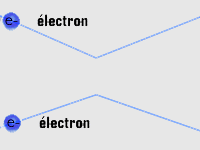Electromagnetic interaction
or
the luminous photon
or
the luminous photon
![]() The
cohesion factor
The
cohesion factor
A body of significant mass, like a planet of more than 300 km in diameter, is dominated by gravitation which imposes upon it a global spherical shape. This perfect shape is spontaneously adopted by all stars and planets.
By contrast, an object with a small mass is dominated by electromagnetic
force
which ensures its internal cohesion. This is why it can have more or less
any form : table, human body or furniture.
Electromagnetism is the best understood of the four interactions and
it presents certain analogies with gravitation, which also has an infinite
range: this is explained by the fact that the mediator boson, the photon,
has a null mass and can therefore act at very long range.
![]()
![]() Unification
of electricity and magnetism
Unification
of electricity and magnetism

In the past, electricity and magnetism were two completely
distinct concepts and they still remain so for the non specialist: as different,
in principle, as the force which moves the needle of a compass and the
electricity which lights our lamps?
All the same, in 1820, Oersted demonstrated that the passage
of an electric current through a conductive filament deviates the needle
of a compass placed beside it: the electric current creates a magnetic
field.
Inversely, the alternating movement of a magnet inside a coil of conductive
wire creates an electric current: this is the well known principle of the
dynamo.
It was in 1873 that the scottish physicist James Clerk Maxwell unified electromagnetism with his equations and established that light is an electromagnetic wave (or disturbance).
Electromagnetic
interaction pulls two particles with an opposite charge Q (as for example
the electron and the atomic nucleus) and repells two particles of the same
charge. In contrast to gravitation, its cumulative effects are thus
cancelled out at larger distances as a result of the global neutrality
of matter: localised attractions and repulsions compensate for one another
on the grand scale.
Each atom is theoretically neutral because it is composed of
as many electrons as protons. In reality, electrons can easily get excited
and jump from one atom to another. In doing this, they create ions,
that is to say incomplete atoms which are electrically charged. It is these
ions which try to complete their external orbitals and which therefore
stick together. These ensembles of atoms form molecules which can
be very complex and very heavy as in the case of the constituants of life.
In assuring the cohesion of objects because of the meeting of electronic
orbitals between atoms and molecules, electromagnetic interaction is thus
the basis of chemistry and biochemistry (or the chemistry of living things).
To know more about interatomic liaisons, do not hesitate to visit the
Cyberbio page which deals with this subject at the address (Translators
note -- this address seems to be missing in the original).
![]()
![]() QED
or quantum electrodynamics
QED
or quantum electrodynamics
The current theory explaining electromagnetism is called quantum
electrodynamics or QED. Verified with an extraordinary precision,
it has the complete confidence of physicists.
It tells us that electromagnetic interaction results from the exchange
of virtual photons, impossible to detect as such. All of the charged particles
(electron, proton...) or those equiped, like the neutron, with a magnetic
moment (like a little magnet) are subject to this law.
| Only neutrinos are subject neither to electromagnetic interaction, gravitational interaction, nor the strong interaction. |
 This
animated diagram, called Feynmans diagram, calls for a little elucidation:
Electron N°1, which approaches N°2, penetrates, at a given moment,
into the electric field of N°2 (and visa versa). It is at this instant
that they both emit a photon and that they change direction: this phenomena
is called the diffusion of electrons. The two fermions do not collide,
each has simply entered the electromagnetic field of the other and is subject
to the action.The notion of a field is a mathematical notion which is very
difficult to imagine. We could say that the space around each electron
seems to have its properties modified at such a point and according
to the proximity of the particle. We don't advance much further!
This
animated diagram, called Feynmans diagram, calls for a little elucidation:
Electron N°1, which approaches N°2, penetrates, at a given moment,
into the electric field of N°2 (and visa versa). It is at this instant
that they both emit a photon and that they change direction: this phenomena
is called the diffusion of electrons. The two fermions do not collide,
each has simply entered the electromagnetic field of the other and is subject
to the action.The notion of a field is a mathematical notion which is very
difficult to imagine. We could say that the space around each electron
seems to have its properties modified at such a point and according
to the proximity of the particle. We don't advance much further!
It is important to remember that the elecromagnetic force only exists
after
the emission of the photon-boson.
![]()
![]() The
new image of the atom
The
new image of the atom
 We
can better imagine, with the aide of QED, the link which unites electrons
(or their diluted quantum version in the form of an orbital) to the nucleus
of the atom. It is necessary to represent this invisible link as an incessant
internal exchange of virtual photons, simultaneously between all of the
electrons and the nucleons of their nucleus. We see there the growing complexity
of the representation of the atom according to the Bohr model.
We
can better imagine, with the aide of QED, the link which unites electrons
(or their diluted quantum version in the form of an orbital) to the nucleus
of the atom. It is necessary to represent this invisible link as an incessant
internal exchange of virtual photons, simultaneously between all of the
electrons and the nucleons of their nucleus. We see there the growing complexity
of the representation of the atom according to the Bohr model.
According to QED, the electromagnetic force derives from the capital role of a virtual particle without mass: the photon. This is a cut down version of the properties and the exchanges of photons between fermions which produce the laws of electricity, magnetism and optics and by extension of all of chemistry and of all life in general.
